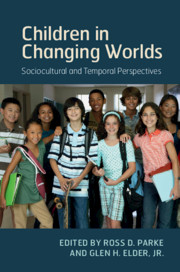Book contents
- Children in Changing Worlds
- Children in Changing Worlds
- Copyright page
- Contents
- List of Figures
- Contributor Biographies
- Preface
- Part I Theoretical and Methodological Approaches: A Cross-Disciplinary Challenge
- Part II Historical and Life Course Transitions: Economic and Demographic Change
- 2 When Societal Events Occur in Lives: Developmental Linkages and Turning Points
- 3 Entering Adulthood in the Great Recession: A Tale of Three Countries
- 4 Developmental Risk and Resilience in the Context of Devastation and Forced Migration
- 5 Children’s Migratory Paths Between Cultures: The Effects of Migration Experiences on the Adjustment of Children and Families
- 6 Education in Historical and Cultural Perspective
- Part III Social, Legal, and Technological Change: Impact on Children
- Part IV Views of the Interdisciplinary Dialogue: From Developmental Science and Sociology
- Author Index
- Subject Index
- References
5 - Children’s Migratory Paths Between Cultures: The Effects of Migration Experiences on the Adjustment of Children and Families
from Part II - Historical and Life Course Transitions: Economic and Demographic Change
Published online by Cambridge University Press: 18 July 2019
- Children in Changing Worlds
- Children in Changing Worlds
- Copyright page
- Contents
- List of Figures
- Contributor Biographies
- Preface
- Part I Theoretical and Methodological Approaches: A Cross-Disciplinary Challenge
- Part II Historical and Life Course Transitions: Economic and Demographic Change
- 2 When Societal Events Occur in Lives: Developmental Linkages and Turning Points
- 3 Entering Adulthood in the Great Recession: A Tale of Three Countries
- 4 Developmental Risk and Resilience in the Context of Devastation and Forced Migration
- 5 Children’s Migratory Paths Between Cultures: The Effects of Migration Experiences on the Adjustment of Children and Families
- 6 Education in Historical and Cultural Perspective
- Part III Social, Legal, and Technological Change: Impact on Children
- Part IV Views of the Interdisciplinary Dialogue: From Developmental Science and Sociology
- Author Index
- Subject Index
- References
Summary
Youth who immigrate to the US navigate unique and increasingly complex challenges. These challenges include stressful or unsafe sociopolitical pre-migration contexts, protracted or unpredictable migration processes, and post-migration stressors while adapting to a new culture. In this chapter, we examine such effects of immigration and acculturation on children in different historical periods. The example of migration from Mexico to the US is used to illustrate how our historical perspectives change and shape developmental possibilities and experiences for children. Our recent historical perspective embraced the goal of assimilating children and families into the US host culture, with little adherence to the values and traditions of the culture of origin. Over time this perspective has shifted to the current view that the goal of acculturation should be a bicultural one. Implications of various migratory paths for children’s adjustment are discussed, as are the developmental implications of current policies related to migration.
- Type
- Chapter
- Information
- Children in Changing WorldsSociocultural and Temporal Perspectives, pp. 112 - 130Publisher: Cambridge University PressPrint publication year: 2019
References
- 2
- Cited by



